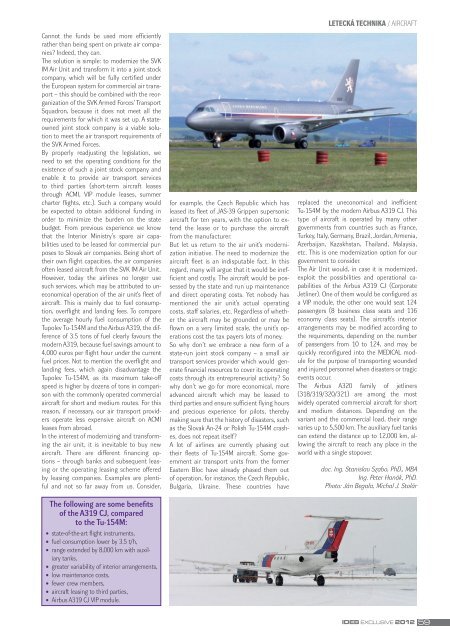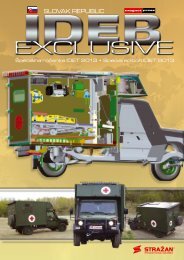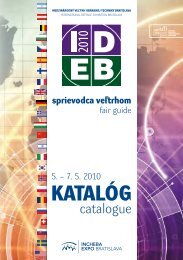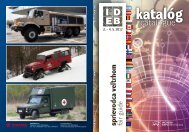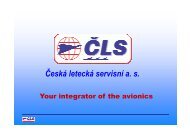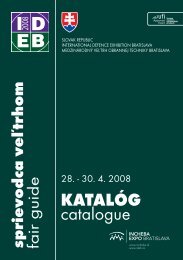tnostà - IDEB â MEDZINÃRODNà VEĽTRH OBRANNEJ TECHNIKY ...
tnostà - IDEB â MEDZINÃRODNà VEĽTRH OBRANNEJ TECHNIKY ...
tnostà - IDEB â MEDZINÃRODNà VEĽTRH OBRANNEJ TECHNIKY ...
Create successful ePaper yourself
Turn your PDF publications into a flip-book with our unique Google optimized e-Paper software.
Cannot the funds be used more efficiently<br />
rather than being spent on private air companies?<br />
Indeed, they can.<br />
The solution is simple: to modernize the SVK<br />
IM Air Unit and transform it into a joint stock<br />
company, which will be fully certified under<br />
the European system for commercial air transport<br />
– this should be combined with the reorganization<br />
of the SVK Armed Forces’ Transport<br />
Squadron, because it does not meet all the<br />
requirements for which it was set up. A stateowned<br />
joint stock company is a viable solution<br />
to meet the air transport requirements of<br />
the SVK Armed Forces.<br />
By properly readjusting the legislation, we<br />
need to set the operating conditions for the<br />
existence of such a joint stock company and<br />
enable it to provide air transport services<br />
to third parties (short-term aircraft leases<br />
through ACMI, VIP module leases, summer<br />
charter flights, etc.). Such a company would<br />
be expected to obtain additional funding in<br />
order to minimize the burden on the state<br />
budget. From previous experience we know<br />
that the Interior Ministry’s spare air capabilities<br />
used to be leased for commercial purposes<br />
to Slovak air companies. Being short of<br />
their own flight capacities, the air companies<br />
often leased aircraft from the SVK IM Air Unit.<br />
However, today the airlines no longer use<br />
such services, which may be attributed to uneconomical<br />
operation of the air unit’s fleet of<br />
aircraft. This is mainly due to fuel consumption,<br />
overflight and landing fees. To compare<br />
the average hourly fuel consumption of the<br />
Tupolev Tu-154M and the Airbus A319, the difference<br />
of 3.5 tons of fuel clearly favours the<br />
modern A319, because fuel savings amount to<br />
4,000 euros per flight hour under the current<br />
fuel prices. Not to mention the overflight and<br />
landing fees, which again disadvantage the<br />
Tupolev Tu-154M, as its maximum take-off<br />
speed is higher by dozens of tons in comparison<br />
with the commonly operated commercial<br />
aircraft for short and medium routes. For this<br />
reason, if necessary, our air transport providers<br />
operate less expensive aircraft on ACMI<br />
leases from abroad.<br />
In the interest of modernizing and transforming<br />
the air unit, it is inevitable to buy new<br />
aircraft. There are different financing options<br />
– through banks and subsequent leasing<br />
or the operating leasing scheme offered<br />
by leasing companies. Examples are plentiful<br />
and not so far away from us. Consider,<br />
The following are some benefits<br />
of the A319 CJ, compared<br />
to the Tu-154M:<br />
state-of-the-art flight instruments,<br />
fuel consumption lower by 3.5 t/h,<br />
range extended by 8,000 km with auxiliary<br />
tanks,<br />
greater variability of interior arrangements,<br />
low maintenance costs,<br />
fewer crew members,<br />
aircraft leasing to third parties,<br />
Airbus A319 CJ VIP module.<br />
for example, the Czech Republic which has<br />
leased its fleet of JAS-39 Grippen supersonic<br />
aircraft for ten years, with the option to extend<br />
the lease or to purchase the aircraft<br />
from the manufacturer.<br />
But let us return to the air unit’s modernization<br />
initiative. The need to modernize the<br />
aircraft fleet is an indisputable fact. In this<br />
regard, many will argue that it would be inefficient<br />
and costly. The aircraft would be possessed<br />
by the state and run up maintenance<br />
and direct operating costs. Yet nobody has<br />
mentioned the air unit’s actual operating<br />
costs, staff salaries, etc. Regardless of whether<br />
the aircraft may be grounded or may be<br />
flown on a very limited scale, the unit’s operations<br />
cost the tax payers lots of money.<br />
So why don’t we embrace a new form of a<br />
state-run joint stock company – a small air<br />
transport services provider which would generate<br />
financial resources to cover its operating<br />
costs through its entrepreneurial activity? So<br />
why don’t we go for more economical, more<br />
advanced aircraft which may be leased to<br />
third parties and ensure sufficient flying hours<br />
and precious experience for pilots, thereby<br />
making sure that the history of disasters, such<br />
as the Slovak An-24 or Polish Tu-154M crashes,<br />
does not repeat itself?<br />
A lot of airlines are currently phasing out<br />
their fleets of Tu-154M aircraft. Some government<br />
air transport units from the former<br />
Eastern Bloc have already phased them out<br />
of operation, for instance, the Czech Republic,<br />
Bulgaria, Ukraine. These countries have<br />
LETECKÁ TECHNIKA / AIRCRAFT<br />
replaced the uneconomical and inefficient<br />
Tu-154M by the modern Airbus A319 CJ. This<br />
type of aircraft is operated by many other<br />
governments from countries such as France,<br />
Turkey, Italy, Germany, Brazil, Jordan, Armenia,<br />
Azerbaijan, Kazakhstan, Thailand, Malaysia,<br />
etc. This is one modernization option for our<br />
government to consider.<br />
The Air Unit would, in case it is modernized,<br />
exploit the possibilities and operational capabilities<br />
of the Airbus A319 CJ (Corporate<br />
Jetliner). One of them would be configured as<br />
a VIP module, the other one would seat 124<br />
passengers (8 business class seats and 116<br />
economy class seats). The aircraft’s interior<br />
arrangements may be modified according to<br />
the requirements, depending on the number<br />
of passengers from 10 to 124, and may be<br />
quickly reconfigured into the MEDICAL module<br />
for the purpose of transporting wounded<br />
and injured personnel when disasters or tragic<br />
events occur.<br />
The Airbus A320 family of jetliners<br />
(318/319/320/321) are among the most<br />
widely operated commercial aircraft for short<br />
and medium distances. Depending on the<br />
variant and the commercial load, their range<br />
varies up to 5,500 km. The auxiliary fuel tanks<br />
can extend the distance up to 12,000 km, allowing<br />
the aircraft to reach any place in the<br />
world with a single stopover.<br />
doc. Ing. Stanislav Szabo, PhD., MBA<br />
Ing. Peter Hanák, PhD.<br />
Photo: Ján Begala, Michal J. Stolár<br />
<strong>IDEB</strong> EXCLUSIVE 2012 59


